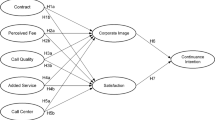Abstract
We formulate a theoretical model in which we postulate that if customers' behavior is perceived as not optimal, customers will adjust this behavior based on their current satisfaction and payment equity. Furthermore, customers will also include new experiences. In our empirical study we particularly investigate customer referrals and the amount of services purchased. Our results show positive effects of current satisfaction and payment equity on referrals, while also changes in satisfaction and payment equity affect customer referrals. With respect to the amount of services purchased, our estimation results reveal a positive significant effect of only changes in satisfaction.
Similar content being viewed by others
References
Anderson, Eugene W., and Mary W. Sullivan. (1993). ''The Antecedents and Consequences of Customer Satisfaction for Firms,'' Marketing Science, 12(2), 125–143.
Bolton, Ruth N. (1998). ''A Dynamic Model of the Duration of the Customer's Relationship with a Continuous Service Provider: The Role of Satisfaction,'' Marketing Science, 17(1), 45–65.
Bolton, Ruth N., and Katherine N. Lemon. (1999). ''A Dynamic Model of Customers' Usage of Services: Usage as an Antecedent and Consequence of Satisfaction,'' Journal of Marketing Research, 36(2), 171–186.
Boulding, William, Ajay Kalra, Richard Staelin, and Valarie A. Zeithaml. (1993). ''A Dynamic Process Model of Service Quality: From Expectations to Behavioral Intentions,'' Journal of Marketing Research, 30(1), 7–27.
Burnham, Thomas A., Judy K. Frels, and Vijay Mahajan. (2001). The Antecedents and Consequences of Consumer Switching Costs, Working Paper, University of Texas at Austin.
DeKimpe, Marnik G., Dominique M. Hansens, and Jorge M. Silva Russo. (1999). ''Long-run Effects of Price Promotions in Scanner Markets,'' Journal of Econometrics, 89(1/2), 269–291.
Dick, Allan S., and Kunal Basu. (1994). ''Customer Loyalty: Toward an Integrated Conceptual Framework,'' Journal of the Academy of Marketing Science, 22(2), 99–113.
Franses, Philip Hans, and Richard Paap. (2001). Quantitative Models in Marketing Research. Cambridge: Cambridge University Press.
Heckman, James J. (1976). ''The Common Structure of Statistical Models of Truncation, Sample Selection and Limited Dependent Variables and a Simple Estimator for Such Models,'' Annals of Economic and Social Measurement, 5, 475–492.
Hendry, David F., Adrian R. Pagan, and J. Denis Sargan. (1984). ''Dynamic Specification,'' in Handbook of Econometrics, Editors, Z. Griliches and M. D. Intriligator, Vol. 2, Chap. 18, North-Holland: Amsterdam, 1023–1100.
Hogarth, Robin M., and Hillel J. Einhorn. (1992). ''Order Effects in Belief Updating: The Belief Adjustment Model,'' Cognitive Psychology, 24(1), 1–55.
Jones, Thomas W., and Earl W. Jr. Sasser. (1995). ''Why Satisfied Customers Defect?,'' Harvard Business Review, 73(6), 88–90.
Leeflang, Peter S., Dick R. Wittink, Michel Wedel, and Philippe A. Naert. (2000). Building Models for Marketing Decisions. Boston: Kluwer Academic Publishers.
Mazursky, David, and Aviva Geva. (1989). ''Temporal Decay in Satisfaction-Purchase Intention Relationship,'' Psychology and Marketing, 6(3), 211–227.
Mela, Carl F., Sunil Gupta, and Donald R. Lehmann. (1997). ''The Long-Term Impact of Promotion and Advertising on Consumer Brand Choice,'' Journal of Marketing Research, 34(2), 248–261.
Mittal, Vikas, Pankaj Kumar, and Michael Tsiros. (1999). ''Attribute-Level Performance, Satisfaction, and Behavioral Intentions over Time: A Consumption System Approach,'' Journal of Marketing, 63(2), 88–101.
Mittal, Vikas, and Wagner A. Kamakura. (2001). ''Satisfaction, Repurchase Intent, and Repurchase Behavior: Investigating the Moderating Effect of Customer Characteristics,'' Journal of Marketing Research, 38(1), 131–142.
Nunnally, Jun C. (1978). Psychometric Theory. New York: McGraw-Hill.
Oliver, Rick L. and Russell S. Winer. (1987). ''A Framework for the Formation and Structure of Consumer Expectations: Review and Propositions,'' Journal of Economic Psychology, 8, 469–499.
Paap, Richard, and Philip Hans Franses. (2000). ''A Dynamic Multinomial Probit Model for Brand Choice with Different Long-Run and Short-Run Effects of Marketing-Mix Variables,'' Journal of Applied Econometrics, 15, 714–744.
Rust, Roland T., Jeffrey Inman, Jianmin Jia, and Anthony Zahorik. (1999). ''What You Don't Know about Customer Perceived Quality: The Role of Customer Expectation Distributions,'' Marketing Science, 18(1), 77–92.
Singh, Jagdip. (1990). ''Voice, Exit and Negative Word-of-Mouth Behaviors: An Investigation across three Service Categories,'' Journal of the Academy of Marketing Science, 18(1), 1–15.
Verhoef, Peter C., Philip Hans Franses, and Janny C. Hoekstra. (1999). The Impact of Satisfaction on the Breadth of the Relationship, Ribes Working Paper, Erasmus University Rotterdam.
von Neumann, J., and O. Morgenstern. (1947). Theory of Games and Economic Behavior. Princeton, NJ: Princeton University Press.
Woodruff, Robert B. (1997). ''Customer Value: The Next Source for Competitive Advantage,'' Journal of the Academy of Marketing Science, 25(2), 139–153.
Zeithaml, Valerie A., Leonard L. Berry, and A. Parasuraman. (1996). ''The Behavioral Consequences of Service Quality,'' Journal of Marketing, 60(2), 31–46.
Author information
Authors and Affiliations
Rights and permissions
About this article
Cite this article
Verhoef, P.C., Franses, P.H. & Donkers, B. Changing Perceptions and Changing Behavior in Customer Relationships. Marketing Letters 13, 121–134 (2002). https://doi.org/10.1023/A:1016093819299
Issue Date:
DOI: https://doi.org/10.1023/A:1016093819299



